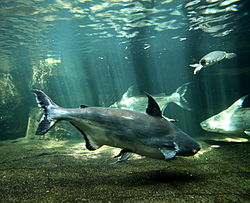Pangasius
|
Pangasius Temporal range: Paleogene - Recent |
|
|---|---|
 |
|
| Pangasius sanitwongsei | |
| Scientific classification | |
| Kingdom: | Animalia |
| Phylum: | Chordata |
| Class: | Actinopterygii |
| Order: | Siluriformes |
| Family: | Pangasiidae |
| Genus: |
Pangasius Valenciennes, 1840 |
| Type species | |
|
Pangasius buchanani Valenciennes, 1840 |
|
| Species | |
|
See text. |
|
| Synonyms | |
|
|
See text.
Pangasius is a genus of medium-large to very large shark catfishes native to fresh water in South and Southeast Asia. The term "pangasius" is sometimes used to specifically refer to the commercially important basa fish, P. bocourti.
In 1993, Pangasius was one of two extant genera (along with Helicophagus) in the family Pangasiidae. At this point, it was split into four subgenera. Pangasius (Pangasianodon) included P. gigas and P. hypophthalmus and was diagnosed by the absence of mandibular barbels, the absence of teeth in adults and the presence of a single-lobed swimbladder. Pangasius (Pteropangasius) included P. micronema and P. pleurotaenia and was diagnosed by four lobes in the swimbladder and with multiple segments in the last lobe. Pangasius (Neopangasius) included P. nieuwenhuisii, P. humeralis, P. lithostoma, P. kinabatanganensis, diagnosed by palatal teeth arranged in a single large patch and high vertebral counts. Pangasius (Pangasius) was the final subgenus and had no diagnostic features, containing the remaining species. These subgeneric classifications were confirmed in 2000 except for Neopangasius, found to be polyphyletic and to be part of Pangasius (Pangasius), thus leaving three subgenera.
Since then, the subgenera have been variably recognized as separate. P. gigas and P. hypophthalmus have been classified in the genus Pangasianodon, and P. micronemus and P. pleurotaenia in the genus Pseudolais (with Pteropangasius as a junior synonym).
...
Wikipedia
